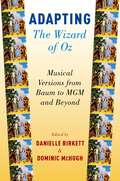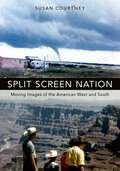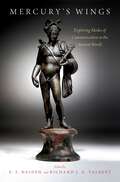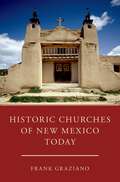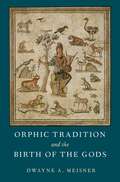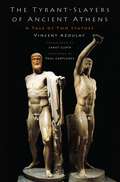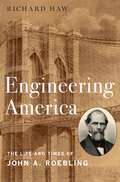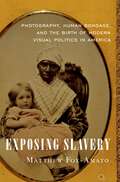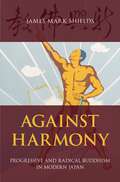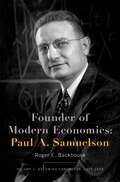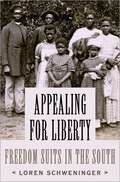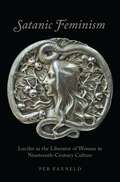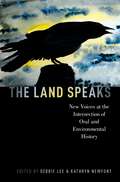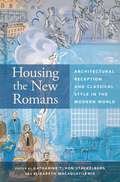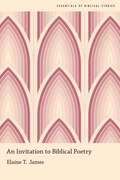- Table View
- List View
ADAPTING WIZARD OF OZ C: Musical Versions from Baum to MGM and Beyond
by Danielle Birkett and Dominic McHughOne of the most beloved film musicals of all time, The Wizard of Oz represents an enduring family favorite and cultural classic. Yet there is much more to the story than meets the eye, and the MGM movie is just one of many ways in which it has been represented. In this lively and wide-ranging book, editors Danielle Birkett and Dominic McHugh bring together insights from eleven experts into the varied musical forms this great American myth has taken in the past century. Starting with the early adaptations of L. Frank Baum's story, the book also explores the writing, composition and reception of the MGM film, its importance in queer culture, stage adaptations of the movie, cult classic The Wiz, Stephen Schwartz's Broadway blockbuster Wicked, and the cultural afterlife of the iconic Arlen-Harburg songs. What emerges is a vivid overview of how music - on stage and screen - has been an essential part of the story's journey to become a centerpiece of American culture.
SPLIT SCREEN NATION C: Moving Images of the American West and South
by Susan CourtneySplit Screen Nation traces an oppositional dynamic between the screen West and the screen South that was unstable and dramatically shifting in the decades after WWII, and has marked popular ways of imagining the U.S. ever since. If this dynamic became vivid in Quentin Tarantino's Django Unchained (2012), itself arguably a belated response to Easy Rider (1969), this book helps us understand those films, and much more, through an eclectic history of U.S. screen media from the postwar era. It deftly analyzes not only Hollywood films and television, but also educational and corporate films, amateur films (aka "home movies"), and military and civil defense films featuring "tests" of the atomic bomb in the desert. Attentive to sometimes profoundly different contexts of production and consumption shaping its varied examples, Split Screen Nation argues that in the face of the Cold War and the civil rights struggle an implicit, sometimes explicit, opposition between the screen West and the screen South nonetheless mediated the nation's most paradoxical narratives--namely, "land of the free"/land of slavery, conquest, and segregation. Whereas confronting such contradictions head-on could capsize cohesive conceptions of the U.S., by now familiar screen forms of the West and the South split them apart to offer convenient, discrete, and consequential imaginary places upon which to collectively project avowed aspirations and dump troubling forms of national waste. Pinpointing some of the most severe yet understudied postwar trends fueling this dynamic--including non-theatrical film road trips, feature films adapted from Tennessee Williams, and atomic test films--and mining their potential for more complex ways of thinking and feeling the nation, Split Screen Nation considers how the vernacular screen forms at issue have helped shape how we imagine not only America's past, but also the limits and possibilities of its present and future.
Mercury's Wings: Exploring Modes of Communication in the Ancient World
by F. S. Naiden and Richard J. A. TalbertMercury's Wings: Exploring Modes of Communication in the Ancient World is the first-ever volume of essays devoted to ancient communications. Comparable previous work has been mainly confined to articles on aspects of communication in the Roman empire. This set of 18 essays with an introduction by the co-editors marks a milestone, therefore, that demonstrates the importance and rich further potential of the topic. The authors, who include art historians, Assyriologists, Classicists and Egyptologists, take the broad view of communications as a vehicle not just for the transmission of information, but also for the conduct of religion, commerce, and culture. Encompassed within this scope are varied purposes of communication such as propaganda and celebration, as well as profit and administration. Each essay deals with a communications network, or with a means or type of communication, or with the special features of religious communication or communication in and among large empires. The spatial, temporal, and cultural boundaries of the volume take in the Near East as well as Greece and Rome, and cover a period of some 2,000 years beginning in the second millennium BCE and ending with the spread of Christianity during the last centuries of the Roman Empire in the West. In all, about one quarter of the essays deal with the Near East, one quarter with Greece, one quarter with Greece and Rome together, and one quarter with the Roman empire and its Persian and Indian rivals. Some essays concern topics in cultural history, such as Greek music and Roman art; some concern economic history in both Mesopotamia and Rome; and some concern traditional historical topics such as diplomacy and war in the Mediterranean world. Each essay draws on recent work in the theory of communications.
Historic Churches of New Mexico Today
by Frank GrazianoThis interpretive guide combines history and ethnography to represent living traditions at the adobe and stone churches of New Mexico. Each chapter treats a particular church or group of churches and includes photographs, practical information for visitors, and context pertinent to current understanding. Frank Graziano provides unprecedented coverage of the churches by combining his extensive fieldwork with research in archives and previous scholarship. The book is written in an engaging narrative prose that brings the reader inside of congregations in Indian and Hispanic villages. The focus is less on church buildings than on people in relation to churches -- parishioners, caretakers, priests, restorers -- and on the author's experiences researching among them.
Historic Churches of New Mexico Today
by Frank GrazianoThis interpretive guide combines history and ethnography to represent living traditions at the adobe and stone churches of New Mexico. Each chapter treats a particular church or group of churches and includes photographs, practical information for visitors, and context pertinent to current understanding. Frank Graziano provides unprecedented coverage of the churches by combining his extensive fieldwork with research in archives and previous scholarship. The book is written in an engaging narrative prose that brings the reader inside of congregations in Indian and Hispanic villages. The focus is less on church buildings than on people in relation to churches -- parishioners, caretakers, priests, restorers -- and on the author's experiences researching among them.
Orphic Tradition and the Birth of the Gods
by Dwayne A. MeisnerThe hatching of the Cosmic Egg, the swallowing of Phanes by Zeus, and the murder of Dionysus by the Titans were just a few of the many stories that appeared in ancient Greek epic poems that were thought to have been written by the legendary singer Orpheus. Most of this poetry is now lost, surviving only in the form of brief quotations by Greek philosophers. Orphic Tradition and the Birth of the Gods brings together the scattered fragments of four Orphic theogonies: the Derveni, Eudemian, Hieronyman, and Rhapsodic theogonies. Typically, theogonies are thought to be poetic accounts of the creation of the universe and the births of the gods, leading to the creation of humans and the establishment of the present state of the cosmos. The most famous example is Hesiod's Theogony, which unlike the Orphic theogonies has survived. But did Orphic theogonies look anything like Hesiod's Theogony? Meisner applies a new theoretical model for studying Orphic theogonies and suggests certain features that characterize them as different from Hesiod: the blending of Near Eastern narrative elements that are missing in Hesiod; the probability that these were short hymns, more like the Homeric Hymnsr than Hesiod; and the continuous discourse between myth and philosophy that can be seen in Orphic poems and the philosophers who quote them. Most importantly, this book argues that the Orphic myths of Phanes emerging from the Cosmic Egg and Zeus swallowing Phanes are at least as important as the well-known myth of Dionysus being dismembered by the Titans, long thought to have been the central myth of Orphism. As this book amply demonstrates, Orphic literature was a diverse and ever-changing tradition by which authors were able to think about the most current philosophical ideas through the medium of the most traditional poetic forms.
Orphic Tradition and the Birth of the Gods
by Dwayne A. MeisnerThe hatching of the Cosmic Egg, the swallowing of Phanes by Zeus, and the murder of Dionysus by the Titans were just a few of the many stories that appeared in ancient Greek epic poems that were thought to have been written by the legendary singer Orpheus. Most of this poetry is now lost, surviving only in the form of brief quotations by Greek philosophers. Orphic Tradition and the Birth of the Gods brings together the scattered fragments of four Orphic theogonies: the Derveni, Eudemian, Hieronyman, and Rhapsodic theogonies. Typically, theogonies are thought to be poetic accounts of the creation of the universe and the births of the gods, leading to the creation of humans and the establishment of the present state of the cosmos. The most famous example is Hesiod's Theogony, which unlike the Orphic theogonies has survived. But did Orphic theogonies look anything like Hesiod's Theogony? Meisner applies a new theoretical model for studying Orphic theogonies and suggests certain features that characterize them as different from Hesiod: the blending of Near Eastern narrative elements that are missing in Hesiod; the probability that these were short hymns, more like the Homeric Hymnsr than Hesiod; and the continuous discourse between myth and philosophy that can be seen in Orphic poems and the philosophers who quote them. Most importantly, this book argues that the Orphic myths of Phanes emerging from the Cosmic Egg and Zeus swallowing Phanes are at least as important as the well-known myth of Dionysus being dismembered by the Titans, long thought to have been the central myth of Orphism. As this book amply demonstrates, Orphic literature was a diverse and ever-changing tradition by which authors were able to think about the most current philosophical ideas through the medium of the most traditional poetic forms.
The Tyrant-Slayers of Ancient Athens: A Tale of Two Statues
by Vincent Azoulay Janet LloydThis investigation relies on a rash bet: to write the biography of two of the most famous statues in Antiquity, the Tyrannicides. Representing the murderers of the tyrant Hipparchus in full action, these statues erected on the Agora of Athens have been in turn worshipped, outraged, and imitated. They have known hours of glory and moments of hardships, which have transformed them into true icons of Athenian democracy. The subject of this book is the remarkable story of this group statue and the ever-changing significance of its tyrant-slaying subjects. The first part of this book, in six chapters, tells the story of the murder of Hipparchus and of the statues of the two tyrannicides from the end of the sixth century to the aftermath of the restoration of democracy in 403. The second part, in three chapters, chronicles the fate and influence of the statues from the fourth century to the end of the Roman Empire. These chapters are followed by an epilogue that reveals new life for the statues in modern art and culture, including how Nazi Germany and the Soviet Union made use of their iconography. By tracing the long trajectory of the tyrannicides-in deed and art-Azoulay provides a rich and fascinating microhistory that will be of interest to readers of classical art and history.
The Tyrant-Slayers of Ancient Athens: A Tale of Two Statues
by Janet Lloyd Vincent AzoulayThis investigation relies on a rash bet: to write the biography of two of the most famous statues in Antiquity, the Tyrannicides. Representing the murderers of the tyrant Hipparchus in full action, these statues erected on the Agora of Athens have been in turn worshipped, outraged, and imitated. They have known hours of glory and moments of hardships, which have transformed them into true icons of Athenian democracy. The subject of this book is the remarkable story of this group statue and the ever-changing significance of its tyrant-slaying subjects. The first part of this book, in six chapters, tells the story of the murder of Hipparchus and of the statues of the two tyrannicides from the end of the sixth century to the aftermath of the restoration of democracy in 403. The second part, in three chapters, chronicles the fate and influence of the statues from the fourth century to the end of the Roman Empire. These chapters are followed by an epilogue that reveals new life for the statues in modern art and culture, including how Nazi Germany and the Soviet Union made use of their iconography. By tracing the long trajectory of the tyrannicides-in deed and art-Azoulay provides a rich and fascinating microhistory that will be of interest to readers of classical art and history.
Engineering America: The Life and Times of John A. Roebling
by Richard HawJohn Roebling was one of the nineteenth century's most brilliant engineers, ingenious inventors, successful manufacturers, and fascinating personalities. Raised in a German backwater amid the war-torn chaos of the Napoleonic Wars, he immigrated to the US in 1831, where he became wealthy and acclaimed, eventually receiving a carte-blanche contract to build one of the nineteenth century's most stupendous and daring works of engineering: a gigantic suspension bridge to span the East River between New York and Brooklyn. In between, he thought, wrote, and worked tirelessly. He dug canals and surveyed railroads; he planned communities and founded new industries. Horace Greeley called him "a model immigrant"; generations later, F. Scott Fitzgerald worked on a script for the movie version of his life. Like his finest creations, Roebling was held together by the delicate balance of countervailing forces. On the surface, his life was exemplary and his accomplishments legion. As an immigrant and employer, he was respected throughout the world. As an engineer, his works profoundly altered the physical landscape of America. He was a voracious reader, a fervent abolitionist, and an engaged social commentator. His understanding of the natural world, however, bordered on the occult and his opinions about medicine are best described as medieval. For a man of science and great self-certainty, he was also remarkably quick to seize on a whole host of fads and foolish trends. Yet Roebling held these strands together. Throughout his life, he believed in the moral application of science and technology, that bridges--along with other great works of connection, the Atlantic Cable, the Transcontinental Railroad--could help bring people together, erase divisions, and heal wounds. Like Walt Whitman, Roebling was deeply committed to the creation of a more perfect union, forged from the raw materials of the continent. John Roebling was a complex, deeply divided yet undoubtedly influential figure, and this biography illuminates not only his works but also the world of nineteenth-century America. Roebling's engineering feats are well known, but the man himself is not; for alongside the drama of large scale construction lies an equally rich drama of intellectual and social development and crisis, one that mirrored and reflected the great forces, trials, and failures of nineteenth century America.
Engineering America: The Life and Times of John A. Roebling
by Richard HawJohn Roebling was one of the nineteenth century's most brilliant engineers, ingenious inventors, successful manufacturers, and fascinating personalities. Raised in a German backwater amid the war-torn chaos of the Napoleonic Wars, he immigrated to the US in 1831, where he became wealthy and acclaimed, eventually receiving a carte-blanche contract to build one of the nineteenth century's most stupendous and daring works of engineering: a gigantic suspension bridge to span the East River between New York and Brooklyn. In between, he thought, wrote, and worked tirelessly. He dug canals and surveyed railroads; he planned communities and founded new industries. Horace Greeley called him "a model immigrant"; generations later, F. Scott Fitzgerald worked on a script for the movie version of his life. Like his finest creations, Roebling was held together by the delicate balance of countervailing forces. On the surface, his life was exemplary and his accomplishments legion. As an immigrant and employer, he was respected throughout the world. As an engineer, his works profoundly altered the physical landscape of America. He was a voracious reader, a fervent abolitionist, and an engaged social commentator. His understanding of the natural world, however, bordered on the occult and his opinions about medicine are best described as medieval. For a man of science and great self-certainty, he was also remarkably quick to seize on a whole host of fads and foolish trends. Yet Roebling held these strands together. Throughout his life, he believed in the moral application of science and technology, that bridges--along with other great works of connection, the Atlantic Cable, the Transcontinental Railroad--could help bring people together, erase divisions, and heal wounds. Like Walt Whitman, Roebling was deeply committed to the creation of a more perfect union, forged from the raw materials of the continent. John Roebling was a complex, deeply divided yet undoubtedly influential figure, and this biography illuminates not only his works but also the world of nineteenth-century America. Roebling's engineering feats are well known, but the man himself is not; for alongside the drama of large scale construction lies an equally rich drama of intellectual and social development and crisis, one that mirrored and reflected the great forces, trials, and failures of nineteenth century America.
Exposing Slavery: Photography, Human Bondage, and the Birth of Modern Visual Politics in America
by Matthew Fox-AmatoWithin a few years of the introduction of photography into the United States in 1839, slaveholders had already begun commissioning photographic portraits of their slaves. Ex-slaves-turned-abolitionists such as Frederick Douglass had come to see how sitting for a portrait could help them project humanity and dignity amidst northern racism. In the first decade of the medium, enslaved people had begun entering southern daguerreotype studios of their own volition, posing for cameras, and leaving with visual treasures they could keep in their pockets. And, as the Civil War raged, Union soldiers would orchestrate pictures with fugitive slaves that envisioned racial hierarchy as slavery fell. In these ways and others, from the earliest days of the medium to the first moments of emancipation, photography powerfully influenced how bondage and freedom were documented, imagined, and contested. By 1865, it would be difficult for many Americans to look back upon slavery and its fall without thinking of a photograph. Exposing Slavery explores how photography altered and was, in turn, shaped by conflicts over human bondage. Drawing on an original source base that includes hundreds of unpublished and little-studied photographs of slaves, ex-slaves, free African Americans, and abolitionists, as well as written archival materials, it puts visual culture at the center of understanding the experience of late slavery. It assesses how photography helped southerners to defend slavery, enslaved people to shape their social ties, abolitionists to strengthen their movement, and soldiers to pictorially enact interracial society during the Civil War. With diverse goals, these peoples transformed photography from a scientific curiosity into a political tool over only a few decades. This creative first book sheds new light on conflicts over late American slavery, while also revealing a key moment in the relationship between modern visual culture and racialized forms of power and resistance.
Exposing Slavery: Photography, Human Bondage, and the Birth of Modern Visual Politics in America
by Matthew Fox-AmatoWithin a few years of the introduction of photography into the United States in 1839, slaveholders had already begun commissioning photographic portraits of their slaves. Ex-slaves-turned-abolitionists such as Frederick Douglass had come to see how sitting for a portrait could help them project humanity and dignity amidst northern racism. In the first decade of the medium, enslaved people had begun entering southern daguerreotype studios of their own volition, posing for cameras, and leaving with visual treasures they could keep in their pockets. And, as the Civil War raged, Union soldiers would orchestrate pictures with fugitive slaves that envisioned racial hierarchy as slavery fell. In these ways and others, from the earliest days of the medium to the first moments of emancipation, photography powerfully influenced how bondage and freedom were documented, imagined, and contested. By 1865, it would be difficult for many Americans to look back upon slavery and its fall without thinking of a photograph. Exposing Slavery explores how photography altered and was, in turn, shaped by conflicts over human bondage. Drawing on an original source base that includes hundreds of unpublished and little-studied photographs of slaves, ex-slaves, free African Americans, and abolitionists, as well as written archival materials, it puts visual culture at the center of understanding the experience of late slavery. It assesses how photography helped southerners to defend slavery, enslaved people to shape their social ties, abolitionists to strengthen their movement, and soldiers to pictorially enact interracial society during the Civil War. With diverse goals, these peoples transformed photography from a scientific curiosity into a political tool over only a few decades. This creative first book sheds new light on conflicts over late American slavery, while also revealing a key moment in the relationship between modern visual culture and racialized forms of power and resistance.
Against Harmony: Progressive and Radical Buddhism in Modern Japan
by James Mark ShieldsAgainst Harmony traces the history of progressive and radical experiments in Japanese Buddhist thought and practice, from the mid-Meiji period through the early Showa. Perhaps the two best representations of progressive Buddhism during this time were the New Buddhist Fellowship (1899-1915) and the Youth League for Revitalizing Buddhism (1931-1936), both non-sectarian, lay movements well-versed in both classical Buddhist texts and Western philosophy and religion. Their work effectively collapsed commonly held distinctions between religion, philosophy, ethics, politics, and economics. Unlike many others of their day, they did not regard the novel forces of modernization as problematic and disruptive, but as opportunities. James Mark Shields examines the intellectual genealogy and alternative visions of progressive and radical Buddhism in the decades leading up to the Pacific War. Exposing the variety in the conceptions and manifestations of progress, reform, and modernity in this period, he outlines their important implications for postwar and contemporary Buddhism in Japan and elsewhere.
Against Harmony: Progressive and Radical Buddhism in Modern Japan
by James Mark ShieldsAgainst Harmony traces the history of progressive and radical experiments in Japanese Buddhist thought and practice, from the mid-Meiji period through the early Showa. Perhaps the two best representations of progressive Buddhism during this time were the New Buddhist Fellowship (1899-1915) and the Youth League for Revitalizing Buddhism (1931-1936), both non-sectarian, lay movements well-versed in both classical Buddhist texts and Western philosophy and religion. Their work effectively collapsed commonly held distinctions between religion, philosophy, ethics, politics, and economics. Unlike many others of their day, they did not regard the novel forces of modernization as problematic and disruptive, but as opportunities. James Mark Shields examines the intellectual genealogy and alternative visions of progressive and radical Buddhism in the decades leading up to the Pacific War. Exposing the variety in the conceptions and manifestations of progress, reform, and modernity in this period, he outlines their important implications for postwar and contemporary Buddhism in Japan and elsewhere.
Founder of Modern Economics: Volume 1: Becoming Samuelson, 1915-1948 (Oxford Studies in History of Economics)
by Roger E. BackhousePaul Samuelson was at the heart of a revolution in economics. He was "the foremost academic economist of the 20th century," according to the New York Times, and the first American to win the Nobel Prize in Economics. His work transformed the field of economics and helped give it the theoretical and mathematic rigor that increased its influence in business and policy making. In Founder of Modern Economics, Roger E. Backhouse explores the central importance of Samuelson's personality and social networks to understanding his intellectual development. This is the first of two volumes covering Samuelson's extended and productive life and career. This volume surveys Samuelson's early years growing up in the Midwest to his experiences at the University of Chicago and Harvard University, where leading scholars in economics and other disciplines stimulated and rewarded his curiosity. His thinking was influenced by the natural sciences and he understood that a critical, scientific approach increased insights into important social and economic questions. He realized that these questions could not be answered through rhetorical debate but required rigor. His "eureka" moment came, he said, when "a good fairy whispered to me that math was a skeleton key to solve age old problems in economics." Backhouse traces Samuelson's thinking from his early days to the publication of his groundbreaking book Foundations of Economic Analysis and Economics: An Introductory Analysis, which influenced generations of students. His work set the stage for economics to become a more cohesive and coherent discipline, based on mathematical techniques that provided surprising insights into many important topics, from business cycles to wage and unemployment rates, and from how competition influences trade to how tax rates affects tax collection. Founder of Modern Economics is a profound contribution to understanding how modern economics developed and the thinking of a revolutionary thinker.
Founder of Modern Economics: Volume 1: Becoming Samuelson, 1915-1948 (Oxford Studies in History of Economics)
by Roger E. BackhousePaul Samuelson was at the heart of a revolution in economics. He was "the foremost academic economist of the 20th century," according to the New York Times, and the first American to win the Nobel Prize in Economics. His work transformed the field of economics and helped give it the theoretical and mathematic rigor that increased its influence in business and policy making. In Founder of Modern Economics, Roger E. Backhouse explores the central importance of Samuelson's personality and social networks to understanding his intellectual development. This is the first of two volumes covering Samuelson's extended and productive life and career. This volume surveys Samuelson's early years growing up in the Midwest to his experiences at the University of Chicago and Harvard University, where leading scholars in economics and other disciplines stimulated and rewarded his curiosity. His thinking was influenced by the natural sciences and he understood that a critical, scientific approach increased insights into important social and economic questions. He realized that these questions could not be answered through rhetorical debate but required rigor. His "eureka" moment came, he said, when "a good fairy whispered to me that math was a skeleton key to solve age old problems in economics." Backhouse traces Samuelson's thinking from his early days to the publication of his groundbreaking book Foundations of Economic Analysis and Economics: An Introductory Analysis, which influenced generations of students. His work set the stage for economics to become a more cohesive and coherent discipline, based on mathematical techniques that provided surprising insights into many important topics, from business cycles to wage and unemployment rates, and from how competition influences trade to how tax rates affects tax collection. Founder of Modern Economics is a profound contribution to understanding how modern economics developed and the thinking of a revolutionary thinker.
Appealing for Liberty: Freedom Suits in the South
by Loren SchweningerDred Scott and his landmark Supreme Court case are ingrained in the national memory, but he was just one of multitudes who appealed for their freedom in courtrooms across the country. Appealing for Liberty is the most comprehensive study to give voice to these African Americans, drawing from more than 2,000 suits and from the testimony of more than 4,000 plaintiffs from the Revolutionary era to the Civil War. Through the petitions, evidence, and testimony introduced in these court proceedings, the lives of the enslaved come sharply and poignantly into focus, as do many other aspects of southern society such as the efforts to preserve and re-unite black families. This book depicts in graphic terms, the pain, suffering, fears, and trepidations of the plaintiffs while discussing the legal systemlawyers, judges, juries, and testimonythat made judgments on their "causes," as the suits were often called. Arguments for freedom were diverse: slaves brought suits claiming they had been freed in wills and deeds, were born of free mothers, were descendants of free white women or Indian women; they charged that they were illegally imported to some states or were residents of the free states and territories. Those who testified on their behalf, usually against leaders of their communities, were generally white. So too were the lawyers who took these cases, many of them men of prominence, such as Francis Scott Key. More often than not, these men were slave owners themselves-- complicating our understanding of race relations in the antebellum period. A majority of the cases examined here were not appealed, nor did they create important judicial precedent. Indeed, most of the cases ended at the county, circuit, or district court level of various southern states. Yet the narratives of both those who gained their freedom and those who failed to do so, and the issues their suits raised, shed a bold and timely light on the history of race and liberty in the "land of the free."
Appealing for Liberty: Freedom Suits in the South
by Loren SchweningerDred Scott and his landmark Supreme Court case are ingrained in the national memory, but he was just one of multitudes who appealed for their freedom in courtrooms across the country. Appealing for Liberty is the most comprehensive study to give voice to these African Americans, drawing from more than 2,000 suits and from the testimony of more than 4,000 plaintiffs from the Revolutionary era to the Civil War. Through the petitions, evidence, and testimony introduced in these court proceedings, the lives of the enslaved come sharply and poignantly into focus, as do many other aspects of southern society such as the efforts to preserve and re-unite black families. This book depicts in graphic terms, the pain, suffering, fears, and trepidations of the plaintiffs while discussing the legal systemlawyers, judges, juries, and testimonythat made judgments on their "causes," as the suits were often called. Arguments for freedom were diverse: slaves brought suits claiming they had been freed in wills and deeds, were born of free mothers, were descendants of free white women or Indian women; they charged that they were illegally imported to some states or were residents of the free states and territories. Those who testified on their behalf, usually against leaders of their communities, were generally white. So too were the lawyers who took these cases, many of them men of prominence, such as Francis Scott Key. More often than not, these men were slave owners themselves-- complicating our understanding of race relations in the antebellum period. A majority of the cases examined here were not appealed, nor did they create important judicial precedent. Indeed, most of the cases ended at the county, circuit, or district court level of various southern states. Yet the narratives of both those who gained their freedom and those who failed to do so, and the issues their suits raised, shed a bold and timely light on the history of race and liberty in the "land of the free."
Satanic Feminism: Lucifer as the Liberator of Woman in Nineteenth-Century Culture (Oxford Studies in Western Esotericism)
by Per FaxneldAccording to the Bible, Eve was the first to heed Satan's advice to eat the forbidden fruit and thus responsible for all of humanity's subsequent miseries. The notion of woman as the Devil's accomplice is prominent throughout Christian history and has been used to legitimize the subordination of wives and daughters. In the nineteenth century, rebellious females performed counter-readings of this misogynist tradition. Lucifer was reconceptualized as a feminist liberator of womankind, and Eve became a heroine. In these reimaginings, Satan is an ally in the struggle against a tyrannical patriarchy supported by God the Father and his male priests. Per Faxneld shows how this Satanic feminism was expressed in a wide variety of nineteenth-century literary texts, autobiographies, pamphlets, newspaper articles, paintings, sculptures, and even artifacts of consumer culture like jewelry. He details how colorful figures like the suffragette Elizabeth Cady Stanton, gender-bending Theosophist H. P. Blavatsky, author Aino Kallas, actress Sarah Bernhardt, anti-clerical witch enthusiast Matilda Joslyn Gage, decadent marchioness Luisa Casati, and the Luciferian lesbian poetess Renée Vivien embraced these reimaginings. By exploring the connections between esotericism, literature, art and the political realm, Satanic Feminism sheds new light on neglected aspects of the intellectual history of feminism, Satanism, and revisionary mythmaking.
Satanic Feminism: Lucifer as the Liberator of Woman in Nineteenth-Century Culture (Oxford Studies in Western Esotericism)
by Per FaxneldAccording to the Bible, Eve was the first to heed Satan's advice to eat the forbidden fruit and thus responsible for all of humanity's subsequent miseries. The notion of woman as the Devil's accomplice is prominent throughout Christian history and has been used to legitimize the subordination of wives and daughters. In the nineteenth century, rebellious females performed counter-readings of this misogynist tradition. Lucifer was reconceptualized as a feminist liberator of womankind, and Eve became a heroine. In these reimaginings, Satan is an ally in the struggle against a tyrannical patriarchy supported by God the Father and his male priests. Per Faxneld shows how this Satanic feminism was expressed in a wide variety of nineteenth-century literary texts, autobiographies, pamphlets, newspaper articles, paintings, sculptures, and even artifacts of consumer culture like jewelry. He details how colorful figures like the suffragette Elizabeth Cady Stanton, gender-bending Theosophist H. P. Blavatsky, author Aino Kallas, actress Sarah Bernhardt, anti-clerical witch enthusiast Matilda Joslyn Gage, decadent marchioness Luisa Casati, and the Luciferian lesbian poetess Renée Vivien embraced these reimaginings. By exploring the connections between esotericism, literature, art and the political realm, Satanic Feminism sheds new light on neglected aspects of the intellectual history of feminism, Satanism, and revisionary mythmaking.
The Land Speaks: New Voices at the Intersection of Oral and Environmental History (Oxford Oral History Series)
by Debbie Lee Kathryn NewfontThe Land Speaks explores the intersection of two vibrant fields, oral history and environmental studies. Ranging across farm and forest, city and wilderness, river and desert, this collection of fourteen oral histories gives voice to nature and the stories it has to tell. These essays consider topics as diverse as environmental activism, wilderness management, public health, urban exploring, and smoke jumping. They raise questions about the roles of water, neglected urban spaces, land ownership concepts, protectionist activism, and climate change. Covering almost every region of the United States and part of the Caribbean, Lee and Newfont and their diverse collection of contributors address the particular contributions oral history can make toward understanding issues of public land and the environment. In the face of global warming and events like the Flint water crisis, environmental challenges are undoubtedly among the most pressing issues of our time. These essays suggest that oral history can serve both documentary and problem-solving functions as we grapple with these challenges.
LAND SPEAKS ORALHIS C: New Voices at the Intersection of Oral and Environmental History (Oxford Oral History Series)
by Debbie Lee Kathryn NewfontThe Land Speaks explores the intersection of two vibrant fields, oral history and environmental studies. Ranging across farm and forest, city and wilderness, river and desert, this collection of fourteen oral histories gives voice to nature and the stories it has to tell. These essays consider topics as diverse as environmental activism, wilderness management, public health, urban exploring, and smoke jumping. They raise questions about the roles of water, neglected urban spaces, land ownership concepts, protectionist activism, and climate change. Covering almost every region of the United States and part of the Caribbean, Lee and Newfont and their diverse collection of contributors address the particular contributions oral history can make toward understanding issues of public land and the environment. In the face of global warming and events like the Flint water crisis, environmental challenges are undoubtedly among the most pressing issues of our time. These essays suggest that oral history can serve both documentary and problem-solving functions as we grapple with these challenges.
Housing the New Romans: Architectural Reception and Classical Style in the Modern World
by Elizabeth Macaulay-Lewis Katharine T. Von StackelbergIn the last twenty years, reception studies have significantly enhanced our understanding of the ways in which Classics has shaped modern Western culture, but very little attention has been directed toward the reception of classical architecture. Housing the New Romans: Architectual Reception and Classical Style in the Modern World addresses this gap by investigating ways in which appropriation and allusion facilitated the reception of Classical Greece and Rome through the requisition and redeployment of classicizing tropes to create neo-Antique sites of "dwelling" in the 19th and early 20th centuries. The volume, across nine essays, will cover both European and American iterations of place making, including Sir John Soanes' house in London, the Hôtel de Beauharnais in Paris, and the Getty Villa in California. By focusing on structures and places that are oriented towards private life-houses, hotels, clubs, tombs, and gardens-the volume directs the critical gaze towards diverse and complex sites of curatorial self-fashioning. The goal of the volume is to provide a multiplicity of interpretative frameworks (e.g. object-agency enchantment, hyperreality, memory-infrastructure) that may be applied to the study of architectural reception. This critical approach makes Housing the New Romans the first work of its kind in the emerging field of architectural and landscape reception studies and in the hitherto textually dominated field of classical reception.
An Invitation to Biblical Poetry (Essentials of Biblical Studies)
by Elaine T. JamesAn Invitation to Biblical Poetry is an accessibly written introduction to biblical poetry that emphasizes the aesthetic dimensions of poems and their openness to varieties of context. It demonstrates the irreducible complexity of poetry as a verbal art and considers the intellectual work poems accomplish as they offer aesthetic experiences to people who read or hear them. Chapters walk the reader through some of the diverse ways biblical poems are organized through techniques of voicing, lineation, and form, and describe how the poems' figures are both culturally and historically bound and always dependent on later reception. The discussions consider examples from different texts of the Bible, including poems inset in prose narratives, prophecies, psalms, and wisdom literature. Each chapter ends with a reading of a psalm that offers an acute example of the dimension under discussion. Students and general readers are invited to richer and deeper readings of ancient poems and the subjects, problems, and convictions that occupy their imagination.
